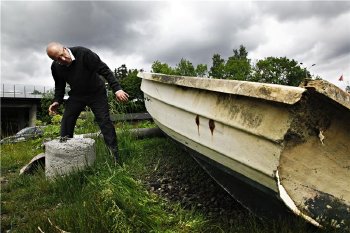Jun 9 2011
Nearly 5,000 recreational boats are retired and disposed of every year in Norway– either sunk to the bottom of the sea or burned in a bonfire. Now, researchers have developed a new method for recycling these vessels.
There are one million recreational boats in Norway, and another 35,000 new boats are purchased and added to the fleet every year. Cabin cruisers, yachts and small boats – big or small, they all rely on composite materials for the hull and the superstructure. The reason for this is that composites are made of cross-linked polyester and fibreglass, which makes them lightweight yet strong.
The only problem is that when a recreational boat gets old and the owner is ready to discard it, there is no way to dispose of it properly – there is no place to take it, and no way to recycle the materials it contains.
 Sinking old recreational boats in the ocean is bad, says Jan Fredrik Bergman of Veolia Miljø, who thinks that recent research results give hope for starting a new kind of recycling company to address the issue. Photo: Scanpix
Sinking old recreational boats in the ocean is bad, says Jan Fredrik Bergman of Veolia Miljø, who thinks that recent research results give hope for starting a new kind of recycling company to address the issue. Photo: Scanpix
“Plastic shopping bags can be melted down and processed, but composite materials have molecular bonds that are not easily broken down,” says SINTEF research director Fabrice Lapique.
In response to this problem, Veolia, a recycling company, started a project three years ago in collaboration with SINTEF Materials and Chemistry, the Norwegian Composite Association, Reichhold and Nordboat. The effort is being supported by the Research Council of Norway. The project called for industry partners to evaluate possibilities for the collection, dismantling and transport of the different fractions of cast-off boats, while the scientists examined whether it is possible to recover the composites from the vessels, and figure out what they can potentially be used for.
Chemical recycling
The results are now available, and are very good. During the course of the project, SINTEF has developed different methods and found a chemical process that makes it possible to separate the polyester and fibreglass so that both products can be reused.
“The process is very effective,” says Lapique. “The level of usability varies from property to property, but is around 80 per cent. And best of all is that the process is easy to implement in an industrial context. Within two hours, more than 80 per cent of the material has been dissolved and the temperature during the process does not exceed 220 degrees.”
Lapique says these results are nothing less than revolutionary. “After having reviewed the scientific literature and developed an idea of the state-of-the-art, we see that we have gone further than other countries,” he says.
Feedstock challenges
Reichhold, which is a leading supplier of unsaturated polyesters and vinyl esters to the composite industry, was sceptical at the beginning that it would be possible to recycle composite materials.
“This is a very positive development, since it has been generally accepted that the process by which plastic is hardened could not be reversed,” says Egil Holtmon, technology director at Reichhold. “This is definitely the way to go, but there is still a lot of work to do before we can bring it into our production systems.”
Reichhold believes that collecting old boats and separating them into different fractions is in itself a large undertaking, but that the biggest challenge lies in providing as a clean a raw material as possible.
“Hardened polyester is mixed with 30 per cent glass fibre, and these two fractions must be separated using chemical treatment. Another issue is that the newest boats contain core materials that must be separated - and many are combined with base materials.”
The company will now wait and see how the report is received before pursuing anything further.
Transport needs to be part of the solution
Jan Fredrik Bergman, who is head of business development at Veolia Miljø, believes that the results give hope for starting a new kind of recycling company. He believes that boat importers and producers are themselves aware of their responsibilities and support the solutions that are sure to be required for the collection and handling of old boats.
But, says Bergman, “the challenges are many. Recreational boats are defined as ‘boats less than 24 meters long’, and boats of that size will involve more than just transporting them to environmentally friendly disposal. Boat transport itself is associated with large costs and should be covered by the system.”
Bergman believes that local authorities must help by accepting small boats, which can be transported on a car or a car with a trailer. These boats can then be transported to an environmental treatment facility.